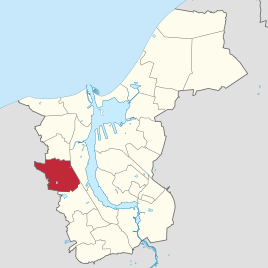Evershagen
|
Evershagen
City of Rostock
|
|
|---|---|
| Coordinates: 54 ° 6 ′ 58 ″ N , 12 ° 3 ′ 34 ″ E | |
| Height : | 5 m above sea level NN |
| Area : | 7 km² |
| Residents : | 16,847 (Dec. 31, 2017) |
| Population density : | 2,407 inhabitants / km² |
| Incorporation : | July 1, 1950 |
| Postal code : | 18069, 18106 |
| Area code : | 0381 |
|
Location of Evershagen in Rostock
|
|
Evershagen is a district of Rostock in Mecklenburg-Western Pomerania .
geography
Some old houses in the village of Evershagen, which gave the district its name, can still be seen to the northwest of the apartment blocks. The Schutow industrial park and a residential area built since 2002 with single, semi-detached and terraced houses are still sometimes referred to as Evershagen-Süd . The streets are named after writers. Allotments and orchards form the western edge of the district. To the northwest, Evershagen ends at Schmarler Bach in the fishing village , a park with a toboggan hill and a pond, which extends into the neighboring district of Lütten Klein .
history
The village of Evershagen was incorporated into Rostock on July 1, 1950.
Even before the residential construction in Lütten Klein , the first new district in the north-west of Rostock, was finished, planning for Evershagen began. Initially, the concept envisaged a central green space with large residential units (mostly five-story) placed around it. However, these plans were revised and the proportion of high-rise buildings increased. At the end of 1970, the five-storey residential construction began, so that the first apartments could be moved into from May 1971. In the following year, residential buildings from the 70 series were built for the first time in Evershagen . In 1974 another five-story apartment blocks were completed. This was followed by the high-rise types known from Lütten Klein, such as the windmills (approx. 50 m high) or the stilt high-rise developed by German and Polish architects, which is now known as the Rasmus high-rise. The terrace skyscrapers, however, were new.
The large , prefabricated housing estate with 8,732 apartments for around 22,000 residents, which characterizes the district, was built between 1969 and 1978 as the second district in the northwest. The construction of high-rise terrace buildings, which are now protected as architectural monuments, was new and remarkable.
Population development
After the number of inhabitants in almost all Rostock districts fell sharply after the political change in 1989, this has remained constant in Evershagen since 2000. Extensive renovations of the buildings, the improvements of the living environment carried out through subsidy programs (including the demolition of three kindergartens, two schools and a "windmill" high-rise ), the development of new construction areas (three new residential areas were created in the 1990s), the good location the city motorway between Rostock city center and Warnemünde, as well as the good connection to the local transport system (bus, S-Bahn, tram) have certainly contributed to this.
Economy and Infrastructure
Transport links
The residential area "Obstplantage" (in the south-western area of Evershagen) can only be reached through the town of Sievershagen in the Rostock district , as it is enclosed from all other sides by the agricultural area that gives it its name. The district has been connected to the urban tram network since 2000.
Schutow industrial park
With the Schutow industrial park, the former site of the Rostock Baltic Sea Fair was prepared for new industrial establishments. Some markets, including the furniture company IKEA , and smaller companies have set up shop. The Baltic Sea Fair was held in the GDR with the aim of demonstrating cosmopolitanism and gaining diplomatic recognition. Some notable buildings were created for this occasion. These include shell constructions by Ulrich Müther .
Sievershagen Mill
The Sievershagen mill ( Lambrechtshagen municipality ) can be found in the middle of an allotment garden through the incorporation of part of the Sievershagen district into Rostock. It was built in 1866 to replace a post mill from 1790. It has not been used since the 1960s. In 1985 the ailing cap was removed for safety reasons.
education
In Evershagen there is a primary school , a vocational school , as well as the Rostock-Evershagen school campus in Thomas-Morus-Straße, which has emerged from a regional school and a grammar school .
Culture
Most of the cultural life takes place in the multi-generation house (formerly a district and meeting center) and the " Pablo Neruda " youth club (oldest cultural institution from the GDR era in Rostock). These two institutions hold a district festival and other activities for the district every year. Between 1983 and 1985, a church with community rooms and service apartments was built for the previously homeless Roman Catholic parish in Evershagen, which is named after the Catholic saint Thomas More . Today, in addition to the Catholic parish of Evershagen, the Evangelical Lutheran parish also uses the building. It is located at Thomas-Morus-Straße 4.
Individual evidence
- ↑ Population by city area on rathaus.rostock.de
- ↑ wiro news . Issue 12/2006 of the customer magazine Wiro Aktuell.
- ↑ ogr.de . Website of the school campus Rostock-Evershagen.
- ↑ Archived copy ( Memento from March 16, 2010 in the Internet Archive )







